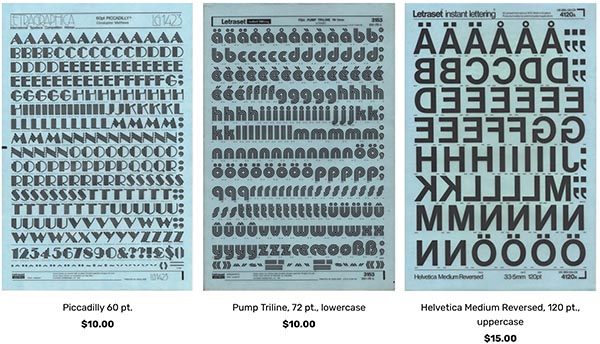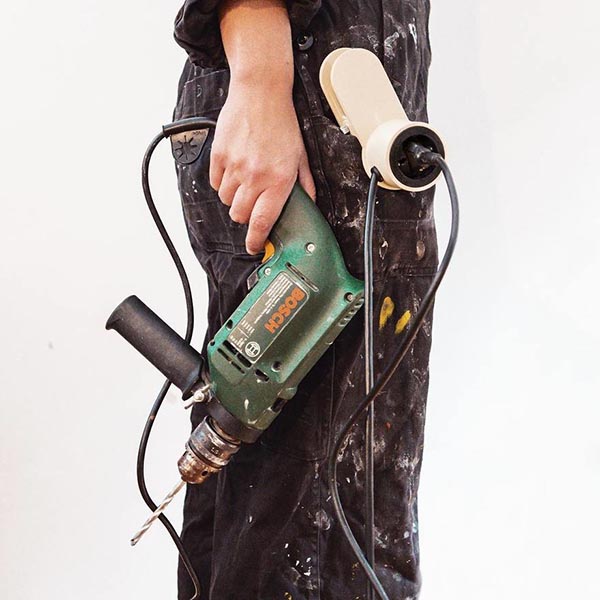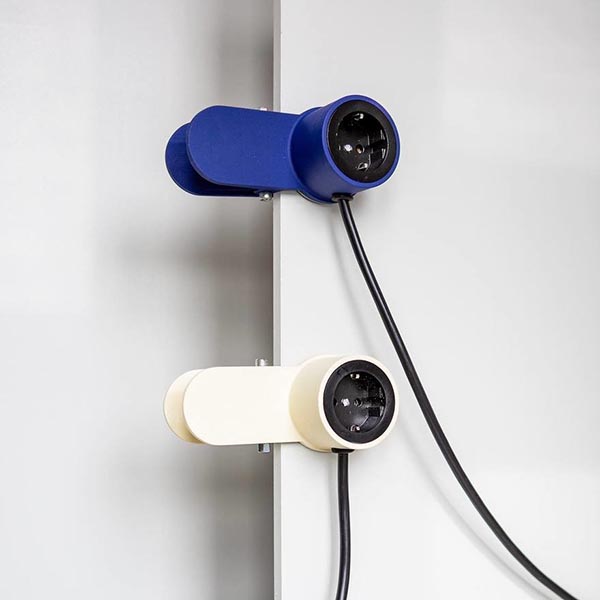Your Friday World’s Violinists Play for Ukraine
Why are we stopping at daylight savings?! Ban 6am. Make it always Friday. Go nuts.
— Mike Scollins (@mikescollins) March 15, 2022
Morning Becomes a Letraset
Do you remember Letraset? (Heck, do you still use Letraset?) Back before desktop publishing or even phototypesetting, Letraset was (and still is!) a brand of dry transfer: it comprised decals applied to the back of a plastic sheet. To apply it, you placed the appropriate character in the desired position and then rubbed the front of the sheet with a stylus or ballpoint pen until the entire decal was transferred. It was not the most efficient typesetting method, but there was a certain satisfaction that came with accurately placed Letraset characters. There were a number of companies producing dry transfer type (and patterns) including Letraset, but that soon became the generic name, like Kleenex did for tissues. Although it lost much of its mainstream appeal, it still had a certain cachet in alternative and punk circles. (It was surprising to hear “Letraset” name-checked in the 2009 Arctic Monkeys song “Cornerstone.”)
Anyway, the company Letraset may not exist anymore (it was acquired in June 2012 by the Colart group and was absorbed by its subsidiary Winsor & Newton), but the product still exists and there is even an online store—Letrashop—dedicated to Letraset.

There are many more options for your old-school typographic needs.
Yes, But Which Half?
Surely there’s an easier way to describe this thing’s size https://t.co/EqiQe8A9tf
— Laura Bassett (@LEBassett) March 14, 2022
The Market Seams Huge
If you haven’t explored opportunities in digital textile printing, you may be missing out. Via Behind the Seams, FMI estimates that the digital textile market will reach US$8 billion by 2029.
Of total value, the share of Direct-to-Fabric (DTF) printing is estimated at 54 per cent. DTF segment is experiencing unmatchable demand in the global digital textile printing market and it is expected to expand at an impressive CAGR of 17.50 per cent during the forecast period.
This market growth is majorly driven by increasing penetration of the printing sector in developing markets such as China, Mexico and India, and technological advancements that have taken place over time.
Majorly? Still:
In terms of market growth, North America and East Asia are estimated to witness commendable growth in the global digital textile printing market, FMI predicts.
Hmm…“commendable growth.” Sounds like damning with faint praise, but analysts have been consistently bullish on domestic growth of digital textile printing as reshoring picks up steam.
Mail Love Not War
I’ve no idea who is crocheting post boxes for Ukraine round my way, but I love them for it. ?? ???? “Letters live in peace”… “Mail love not war”. pic.twitter.com/1yfhKaOB06
— Jonathan Samuels (@jonathansamuels) March 15, 2022
Fiber, but Not Bored
Most folks here are intimately familiar with corrugated cardboard, and are probably heavily involved in either its manufacturing and/or its printing. For those who are into history, educational channel New Mind takes a look at the history, science, and construction of cardboard, including its origin story, which was thanks to the 19th-century advent of wood pulping and the papermaking machine, as well as a seminal 1856 patent granted to Edward Charles Healey and Edward Ellis Allen. Interestingly, the initial use for corrugated cardboard was to make ruffled Elizabethan collars and cushioning for men’s hats. (Now there are some unique future application areas for EFI’s Nozomi platform.) The first patent for a corrugated packaging material was granted to Albert L. Jones in 1871 as a way of protecting glass containers while shipping.
They also identify the staggering amount of corrugated fiberboard we use annually, but point out that: “As of 2020, just under 97% of all expended corrugated packaging is recovered for recycling, making this inexpensive, durable, material an extraordinary recycling success story.”
Cover Model
When the model on the catalog cover is also having some kind of breakdown. pic.twitter.com/lQuEDsKVWT
— Alexander Chee (@alexanderchee) March 12, 2022
NFT Heist!
Stephen Colbert explains how, with the growth of NFTs and some recent high-profile NFT “thefts,” it’s only a matter of time before Hollywood comes out with an NFT heist movie. Colbert beats them to it, with this trailer for NFT Heist!
Very Cross Walk
Instead of telling you when it's safe to cross the street, the walk signs in Crystal City, VA are just repeating "CHANGE PASSWORD".
— Joey Politano (@JosephPolitano) March 13, 2022
Something's gone terribly wrong here. pic.twitter.com/W5h8OjBXUu
In Pod We Trust
Was it a good week for graphene news? It’s always a good week for graphene news! Two words: lifestyle pod. Three words and a hyphen: graphene-enhanced cement. All five words add up to a new product from Versarien: 3D-printed pods made from Cementene, graphene-infused cement. From Graphene-Info.com:
Known as Versarien Lunar, this is a milestone project for a 3D-concrete printed product with a graphene additive. The versatile pods can be used as an office, studio, gym, or leisure room. The pod's wall design shows the level of detail, flexibility and precision that can be achieved with 3D-concrete printing.

We will of course be acquiring one of these for the future home of the Around the Web Cultural Accretion Bunker.
Power Pointer
It's wild when someone in a video call is like "sorry my dog just popped into frame" like please don't be sorry, you have no idea how much more I want to see your dog than your powerpoint
— Ron Iver (@ronnui_) March 15, 2022
When the Classics Weren’t So Classic
The Great Gatsby. Ulysses. To the Lighthouse. We are all likely familiar with at least some entrants in the canon of classic 20th-century novels. However, as Mental Floss points out, what are retrospectively revered as classics were not unanimously thought of as such at the time of their original publication. To wit:
In her review for the New York Evening World, critic Ruth Snyder said, “We are quite convinced after reading The Great Gatsby that Mr. Fitzgerald is not one of the great American writers of to-day.”
Or:
Virginia Woolf…in her diary… called [James Joyce’s] Ulysses “an illiterate, underbred book it seems to me: the book of a self-taught working man, and we all know how distressing they are, how egotistic, insistent, raw, striking, and ultimately nauseating.”
But then:
The New York Evening Post’s cleverly snide review of Woolf’s highly abstract Modernist masterpiece [To the Lighthouse], published in 1927, managed to praise her and shoot her down all in the same sentence: “Her work is poetry; it must be judged as poetry, and all the weaknesses of poetry are inherent in it.”
And also:
Richard Wright’s Native Son, published in 1940, is another classic American novel about the African American experience, but The New Statesman and Nation found the book to be “unimpressive and silly, not even as much fun as a thriller.”
They run through 16 more classics that were initially panned.
No
Is there any writer ever in history who always met deadlines and said it was no big deal to do so?
— Kevin Drum (@kdrum) March 11, 2022
No More Sharing
You may have noticed , if you use the service, that Netflix raised is monthly subscription fee, and they are starting to look for other ways to boost revenue. One of them is cracking down on password sharing, albeit in a passive-aggressive way. Via Gizmodo:
Netflix is trying out a new user-prompt in three countries that asks people to pay a slightly higher fee for using the service across multiple households. But the fee is completely optional, which makes it sound much closer to a guilt tax than a new tier of the service. Feel guilty that you’re getting something for free? Here’s a way to make good.
The company is also testing a new feature that would allow people with an existing profile on the service to transfer that profile—a feature that could theoretically encourage password-sharers to get their own Netflix account. Again, it’s not required, just something Netflix wants you to do out of a sense of obligation.
At least this is better than aggressive-aggressive, such as Hertz’s tendency to report its own customers for auto theft.
Excuses Excuses
Professor Not Buying Student’s Bullshit About Having To Play In NCAA Tournament https://t.co/0e8sfK550i pic.twitter.com/vH5cTVcXVW
— The Onion (@TheOnion) March 15, 2022
Creative Outlets
As the number of electronic devices we own continues to increase, people who live in older homes struggle with the dearth of electrical outlets, and even those of us in somewhat more modern accommodations still find ourselves crawling under desks and other furniture to find an available outlet. This was not lost on Marie Radke, a Masters candidate in Product Design at the Berlin University of the Arts, who finds that power outlets are “still quite undesigned and often not so easy to reach.” So, via Core77, Radke sought to rectify that with a project she calls VOLTA:
“While improvised solutions of multiple sockets under tables or sofas force us to bend and stretch, VOLTA brings the power to you. The collection consists of 3 objects with sockets: a multifunctional lamp, a multiple plug and an extension cord to clamp. So there is always a power outlet within reach.”
Basically, it consists of portable outlets that connect to permanent outlets via extension cords.

Sure, you could just use an extension cord without the need for the outlet, but the clippability of the VOLTA has its appeal:

There is also a trippability factor with extension cords running all over the place, but this may be an idea worth developing further.
Yeah, That’s Got to Go
Instead of “I was today years old when I learned…” try “I just learned” or “I’m very stupid but did you know…”
— Lauren Lapkus ?? (@laurenlapkus) March 16, 2022
Let It Bee
We admit that attracting bees to our homes is not typically something we find desirable. However, bees do serve a vital role as pollinators and many many plant species and many many agricultural crops are wholly dependent on bees for…well, for their continued existence. A healthy population of pollinators is vital for a healthy ecosystem. And while when we think of bees, we usually think of bee hives or vast swarms of hostile stinging insects, there are a fair number of bee species that are not swarming, social insects, but in fact live generally solitary lives. Rather than building big hives that can house hundreds, single bees nest in narrow gaps in damaged bricks or crumbling mortar. They tend to be commonly found in older homes and other buildings, and, like their more social brethren, also perform the vital pollination functions that maintain healthy ecosystems. However, newer constructions with fully intact bricks, mortar, and concrete, lack these bee-friendly gaps. If you live in a new home and want to help out local pollinators, what can you do? Well, says Core77, use the new Bee Brick:
Bee Brick™ is solid at the back and has moulded cavities where the bees will lay their eggs, sealing the entrance with mud or chewed up vegetation. Offspring emerge in the Spring and begin the process of nesting again, repeating the cycle.

Developed by UK-based designers Kate and Gavin Christman, Bee Brick is one of several products sold by their new company Green&Blue. And the bricks themselves help serve a useful environmental purpose:
Green&Blue is based in Cornwall, which has a clay industry manufacturing Cornish China. The Christmans use that industry’s concrete waste to comprise up to 75% of each brick.
They have even caught the attention of local government:
After learning of the Christman’s product, municipal authorities in both Brighton and Hove passed a lawrequiring all new home construction to incorporate Bee Bricks.
The Devil Takes the Escalator
Worst perfume name ever. pic.twitter.com/oYugOv5PRn
— Andrew Bloch (@AndrewBloch) March 10, 2022
Croissant Moon
Do you like bread? And lamps? If yes to both, good news! Via East Fork, pick up one of Yukiko Morita’s Bread Lamps. They are real lamps—and real bread. “Yukiko bakes real bread, then hollows it out, fills it with LED lights, and coats it in a thick resin that keeps it fresh looking forever.”

They are so realistic, they come with a warning: “This is a light, not a snack! Please do not eat it!” All are handmade by Yokiko. Available in Croissant and Petite.
All Maps Amazing and Terrible, Part the Infinity
A map of the world made from timezones pic.twitter.com/UXYsA8eWMj
— Amazing Maps™ (@amazingmap) December 30, 2018
Miley Cyprus#Map #Maps #Terriblemaps #TerribleMap #Cyprus #mileycryus #miley pic.twitter.com/AyvwnrXJaX
— Terrible Maps (@TerribleMaps) February 1, 2020
Ear Candy
Either Mike Tyson needs to lay off his own products, or he got punched in the skull one too many times. Via Sport Bible, Tyson started a cannabis-selling business in 2016, pulling in an estimated $1 million a month from various products. He even owns a 420-acre “weed resort” near Desert Hot Springs in Southern California. He may have jumped the shark with his new product called Mike Bites: edibles in the shape of an ear with a chunk bitten out of it, a “tribute” to the 1997 fight in which he bit off a bit of Evander Holyfield’s ear.
Mike Tyson’s weed company is making edibles in the shape of an ear. Genius pic.twitter.com/VOU3uAMzOf
— Greg Baroth (@gbaroth) March 14, 2022
Apparently, Holyfield has since forgiven him for the incident, and they’re buds now. Still we doubt he’ll be picking up these edibles any time soon.
Pointless
Arguing on Twitter is like beeping your horn in a traffic jam.
— Richard Osman (@richardosman) March 13, 2022
Everyone Knows He’s Slinky
We leave you this week with one of the oddest things you’ll ever see, and once you see it, you can’t unsee it. We give you….the human slinky. (Sorry, YouTube will not allow embedding. That may be a good thing.)
Kinda Kink
Not Ray Davies? https://t.co/G4obz4rh9V
— Michael McKean (@MJMcKean) March 15, 2022
This Week in Printing, Publishing, and Media History
March 14
Happy #PiDay!!! pic.twitter.com/xwHMtOm1D1
— Pee-wee Herman (@peeweeherman) March 14, 2022
1663: Otto von Guericke completes Nature of Space and the Possibility of the Void, which postulated the existence of a vacuum.
1836: English author of Mrs Beeton’s Book of Household Management Isabella Beeton born.
1874: Dutch businessman and co-founder of Philips Electronics Anton Philips born.
1879: German-American physicist, engineer, academic, and Nobel Prize laureate Albert Einstein born.
1885: The Mikado, a light opera by W. S. Gilbert and Arthur Sullivan, receives its first public performance in London.
1931: Alam Ara, India’s first talking film, is released.
1936: The first all-sound film version of Show Boat opens at Radio City Music Hall.
1994: Linux kernel version 1.0.0 is released.
2018: English physicist and author Stephen Hawking dies (b. 1942).
March 15
44 BC: Et tu, Brute? Roman general and statesman Julius Caesar dies (b. 100 BC).
1918: American author, critic, and biographer (James Joyce, Oscar Wilde) Richard Ellmann born.
1937: American short story writer, editor, and novelist H. P. Lovecraft dies (b. 1890).
March 16
1870: The first version of the overture fantasy Romeo and Juliet by Tchaikovsky receives its première performance.
1894: Jules Massenet's opera Thaïs is first performed.
1906: English-American violinist and comedian Henny Youngman born. Take his wife...please!
1926: Robert Goddard launches the first liquid-fueled rocket, at Auburn, Massachusetts.
In 1920, the New York Times published an editorial claiming that Robert Goddard "lack[ed] the knowledge ladled out daily in high schools" and that it was "absurd" to believe that rockets would work in space. They issued a correction 17 July 1969, the day after Apollo 11 launched.
— Quite Interesting (@qikipedia) March 11, 2019
2020: The Dow Jones Industrial Average falls by 2,997.10, the single largest point drop in history and the second-largest percentage drop ever at 12.93%, an even greater crash than Black Monday (1929).
March 17
1941: American singer-songwriter and guitarist Paul Kantner born.
1956: American actor, comedian, screenwriter, and author Fred Allen dies (b. 1894).
1973: The Pulitzer Prize-winning photograph Burst of Joy is taken, depicting a former prisoner of war being reunited with his family, which came to symbolize the end of United States involvement in the Vietnam War.
March 18
1733: German author and bookseller Christoph Friedrich Nicolai born.
1768: Irish novelist and clergyman Laurence Sterne dies (b. 1713).
1850: American Express is founded by Henry Wells and William Fargo.
1932: American novelist, short story writer, and critic John Updike born.
1961: American singer-songwriter and guitarist Grant Hart born.
March 19
1813: Scottish missionary and explorer David Livingstone born, we presume.
1895: Auguste and Louis Lumière record their first footage using their newly patented cinematograph.
1928: Irish-American actor, director, producer, and screenwriter Patrick McGoohan born. Be seeing you.
1931: Gambling is legalized in Nevada.
1933: American novelist Philip Roth born.
1962: Bob Dylan releases his first album, Bob Dylan.
2008: British science fiction writer Arthur C. Clarke dies (b. 1917).
March 20
43 BC: Roman poet Ovid born.
1828: Norwegian poet, playwright, and director Henrik Ibsen born (not in a doll’s house).
1852: Harriet Beecher Stowe’s Uncle Tom’s Cabin is published.
1896: With the approval of Emperor Guangxu, the Qing dynasty post office is opened, marking the beginning of a postal service in China.
1915: Albert Einstein publishes his general theory of relativity.
1922: American actor, director, producer, and screenwriter Carl Reiner born.
1923: The Arts Club of Chicago hosts the opening of Pablo Picasso's first United States showing, entitled Original Drawings by Pablo Picasso, becoming an early proponent of modern art in the United States.
1948: With a Musicians Union ban lifted, the first telecasts of classical music in the United States, under Eugene Ormandy and Arturo Toscanini, are given on CBS and NBC.
1950: English drummer, percussionist, and songwriter Carl Palmer born.
1964: Irish republican and playwright Brendan Behan dies (b. 1923).















Discussion
Only verified members can comment.